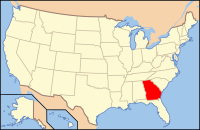Stewart County, Georgia
| Stewart County, Georgia | |
|---|---|

Stewart County courthouse in Lumpkin
|
|
 Location in the U.S. state of Georgia |
|
 Georgia's location in the U.S. |
|
| Founded | December 23, 1830 |
| Named for | Daniel Stewart |
| Seat | Lumpkin |
| Largest city | Richland |
| Area | |
| • Total | 464 sq mi (1,202 km2) |
| • Land | 459 sq mi (1,189 km2) |
| • Water | 4.9 sq mi (13 km2), 1.1% |
| Population | |
| • (2010) | 6,058 |
| • Density | 13/sq mi (5/km²) |
| Congressional district | 2nd |
| Time zone | Eastern: UTC-5/-4 |
| Website | www |
Stewart County is a county located in the west central portion of the U.S. state of Georgia. As of the 2010 census, the population was 6,058. The county seat is Lumpkin. The county was created on December 23, 1830.
The area was inhabited by Native Americans for thousands of years in the Pre-Columbian period. Roods Landing Site on the Chattahoochee River is a significant archaeological site located south of Omaha. Listed on the National Register of Historic Places, it includes major earthwork mounds built about 1100-1350 CE by peoples of the sophisticated Mississippian culture.
The first Europeans to encounter the Native Americans were Spanish explorers in the mid-16th century. At that time the historical Creek tribe inhabited the area, and they maintained their territory until after European American settlers arrived in increasing number in the early decades of the 19th century. The ensuing conflicts ultimately resulted in the Creek people's being driven out of the region. In the 1830s under Indian removal, the federal government forced most Creek to relocate west of the Mississippi River to Indian Territory in present-day Oklahoma.
Under the European Americans, Stewart County was created by an act of the Georgia General Assembly on December 23, 1830, from land that had been part of Randolph County, Georgia. The county is named for Daniel Stewart, a Revolutionary War veteran, fighter against American Indians, and the great-grandfather of U.S. president Theodore Roosevelt.
...
Wikipedia
